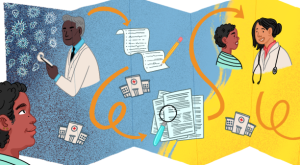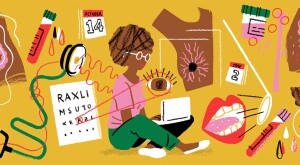There was a burning sensation in the center of my chest that was becoming painful. At first, I attributed the pain to heartburn, since my father had suffered from that, but then I wondered, even though I thought I was too young, could it be a heart attack? An elderly neighbor had recently passed away from a heart attack that she self-diagnosed as gas pains. So I called my doctor, and when he insisted that I go to the ER, off I went. As I thought, and hoped, it was heartburn. I was told to take medication and given instructions on how to treat heartburn (a mere symptom of what I actually had).
But the condition started to become chronic. I had been jolted awake during the night from a feeling of having something caught in my throat that nearly stopped my breathing until I violently coughed to clear the passageway. This had occurred before but was misdiagnosed as an allergic reaction to my cat, and since I had asthma, I believed it.
I still enjoy morning coffee, but only one cup, prepared cold press style (less acidic) with a tiny pinch of baking soda stirred in to further neutralize the acidity.
What is acid reflux?
I went to see a gastroenterologist and was scheduled for an upper endoscopy, a procedure in which a camera called an endoscope is inserted down the throat to check for inflammation or other issues in the esophagus and stomach. I had acid reflux that was developing into a more serious form called gastroesophageal reflux disease, or GERD. Normally, the lower esophageal sphincter (LES) opens to allow food that we’ve eaten into the stomach and then tightly closes to keep food and digestive acids inside. However, if it is weakened or it relaxes at the wrong time, acid is allowed to flow back into the esophagus, causing heartburn and pain. Frequent reflux can lead to GERD.Acid reflux symptoms:
- Burning sensation in the chest (heartburn) after eating; can be worse at night or when lying down.
- Regurgitation of food, nausea.
- Upper abdominal and chest pain that sometimes radiates to the back.
- Sensation of a lump or blockage in the throat. (Sometimes I woke up at night feeling as if I had stopped breathing, and I had to cough to clear it.)
- Trouble swallowing, sore throat, laryngitis.
- Frequent burping, chronic dry cough, hiccups.
- Stomach fullness/bloating.
Seriously? Give up chocolate?
Initially, I was encouraged to eliminate common triggers like coffee (you’ve got to be kidding me!), tea, chocolate, onions, citrus, tomatoes, tomato-based meals, alcohol, carbonated beverages, full-fat dairy, and spicy, oily, greasy, fatty and fried foods. I use onions, tomatoes and tomato sauce in almost every meal I make! It was torture. And boring. Many health professionals have stopped suggesting restrictive, bland diets that eliminate everything on the “do not consume” list because triggers depend on the individual.My food diary is a game changer
Now when reflux is triggered, I cut out the worst offenders until I’ve healed, and I keep a food diary of everything I eat during the day, noting when I have reactions. Oily foods, tomato-based sauces (I’m weeping) and sodas are major offenders for me. I’ve had to learn to pay attention to the warning signs. A slight pain in the chest after eating or the beginning of a dry cough is a mild reaction easily solved by cutting back on things that trigger me. Throat obstruction or chest pain sometimes accompanied by upper back pain means it has gone too far, and I’ll probably need medication.What I’ve learned about medications
I had been prescribed pantoprazole. Unfortunately, when used for more than four weeks, proton pump inhibitors (PPIs) like pantoprazole and esomeprazole can cause gastric acid rebound after you discontinue use. Plus, PPIs present possible osteoporosis and fracture risks. Some medications, such as pain relievers like ibuprofen and aspirin, and drugs to treat bone loss like alendronate (Fosamax) can aggravate symptoms of GERD. During that acid reflux episode, I was on alendronate.Helpful routines could mean less dependence on drugs
Now I do whatever I can to prevent needing medication. It takes diligence, but these steps have been helpful at keeping reflux at bay.
- I start the day with a cup of yogurt, which seems to coat and soothe my stomach.
- I still enjoy morning coffee, but only one cup, prepared cold press style (less acidic) with a tiny pinch of baking soda stirred in to further neutralize the acidity.
- During the day I drink water or herbal tea. The best teas for this condition are chamomile, ginger, fennel, licorice, slippery elm, turmeric and marshmallow root. I avoid peppermint and other mint teas.
- Other foods that are helpful are low-acidic juices and smoothies, oatmeal, bananas, carrots, cucumbers, spinach, cabbage, pears, watermelon, apples, papayas, healthy fats, fiber-rich foods and plant-based milk.
- Since most vegetables do not pose a problem, I’m working back to a more plant-based diet. Fruits, however, are a different story. Citrus fruits are too acidic.
- I eat slowly and avoid rushing through a meal.
- I also eat small meals during the day rather than three large daily meals to ensure that I don’t overeat. You don’t want to feel stuffed or cause a distended abdomen. I avoid exercising for two hours after a meal.
- I don’t go without a meal for more than three hours, or stomach acid can collect.
- After meals I chew gum to stimulate saliva and help neutralize stomach acid. This encourages frequent swallowing, which clears irritating acid from the esophagus more quickly. It has to be cinnamon or fruit-flavored gum, not mint.
- I limit fluids with meals. Liquids add to the volume of food in the stomach. A full or bloated belly puts more pressure on the LES. So I’ll either take small sips between bites or have beverages between meals.
- I remain upright for at least two hours after eating and try not to eat within three to four hours of going to bed. It is also suggested to raise the head of your bed 4 to 6 inches to reduce acid reflux while sleeping. I use a foam wedge pillow.
- I mellow out. Sometimes merely thinking that I’ll be triggered causes a flare-up, so I do things to reduce stress, such as deep breathing. Diaphragmatic breathing and exercises that strengthen the diaphragm muscles around the LES are helpful. A study published in The American Journal of Gastroenterology found five exercises that may help acid reflux sufferers by strengthening the LES. Physiotherapist Michelle Kenway demonstrates how to do the exercises in a YouTube video.
- I’ve made adjustments to my yoga practice. Rapid-paced or sharp breathing like breath of fire, inversions like Downward-Facing Dog or strenuous high-impact exercising while experiencing acid reflux may worsen symptoms. During times when heartburn is active, I don’t wear anything tight-fitting (such as yoga pants) that puts pressure on the stomach.
Just like folks who have a propensity toward high blood pressure or high cholesterol, I have to adjust my lifestyle and stay vigilant to keep acid reflux at bay.











